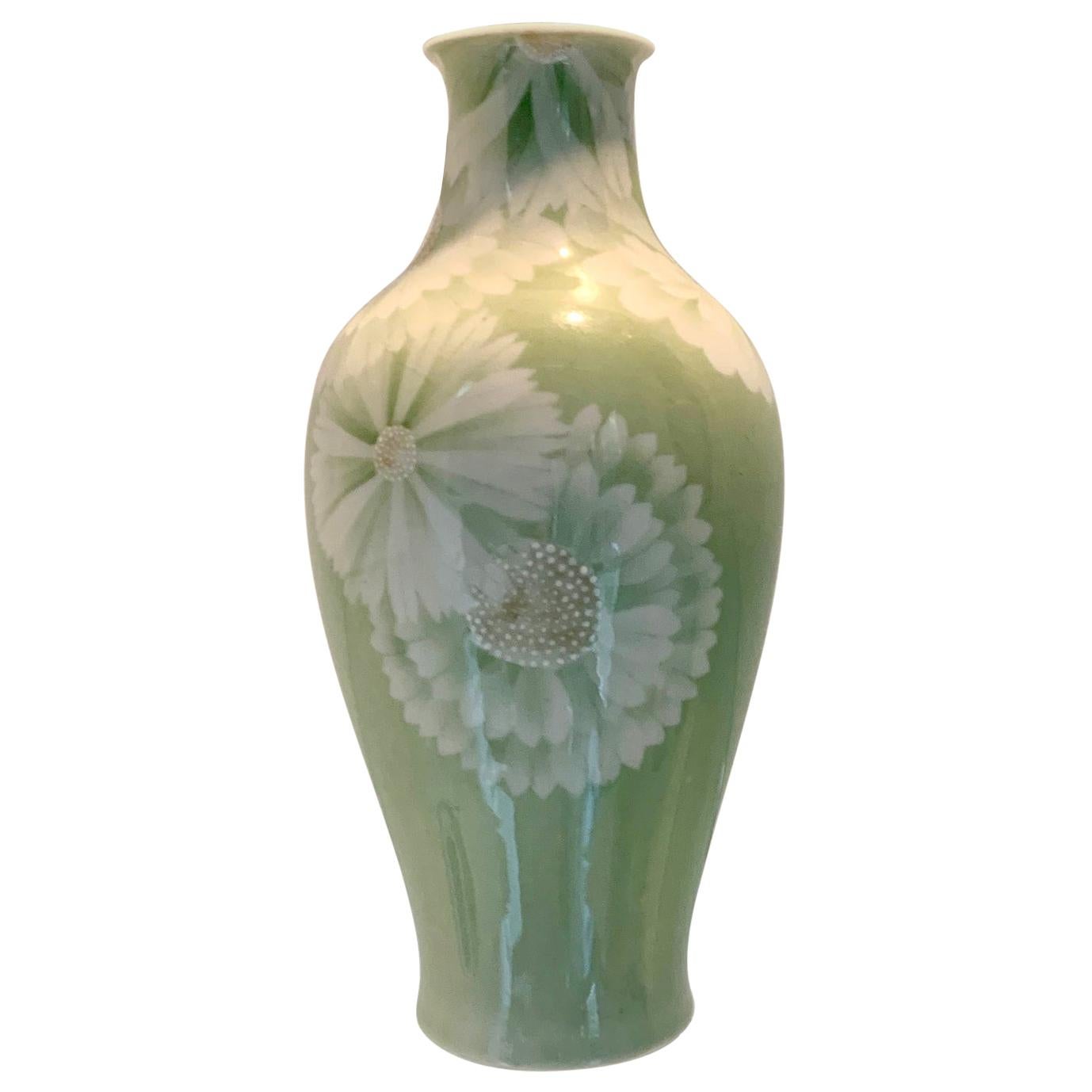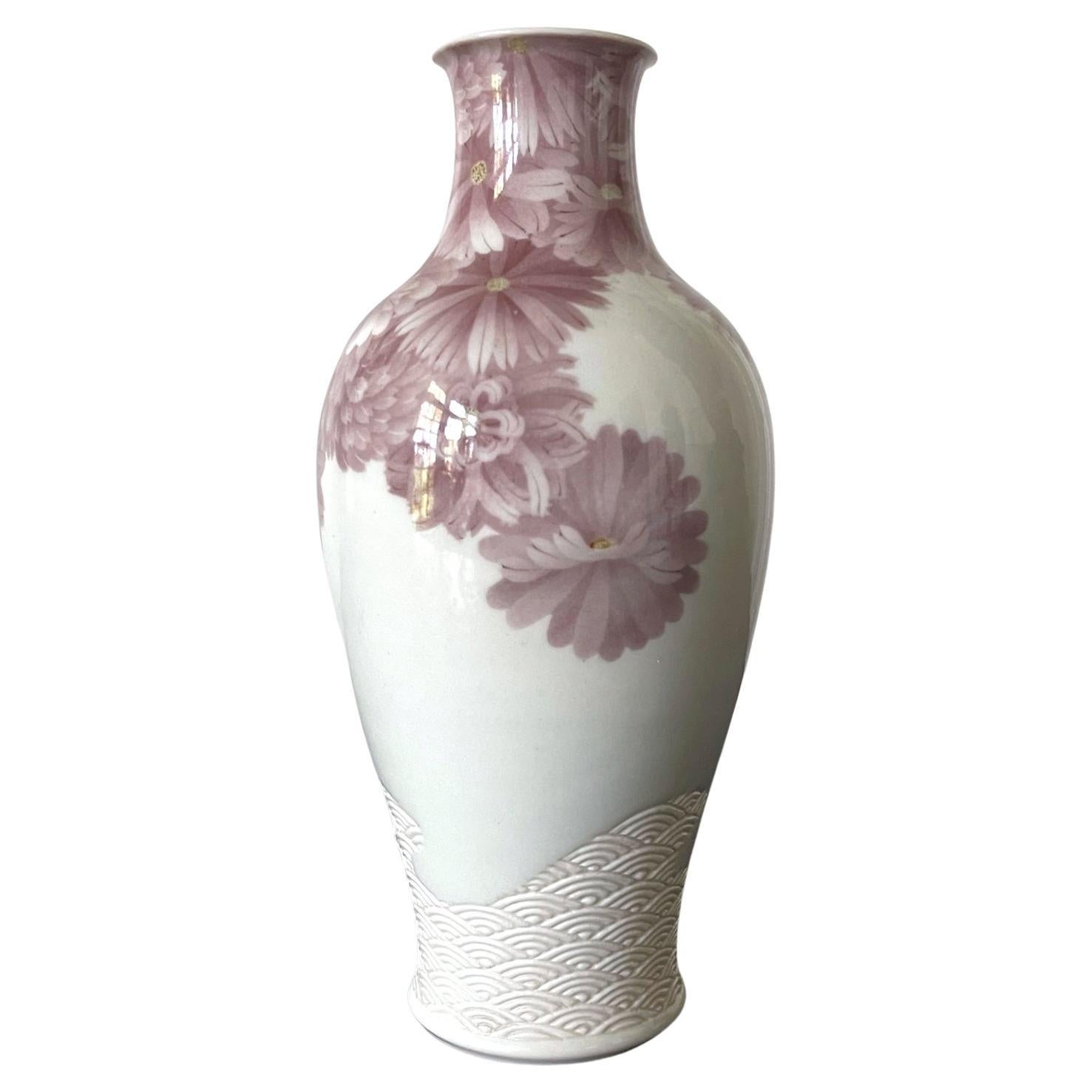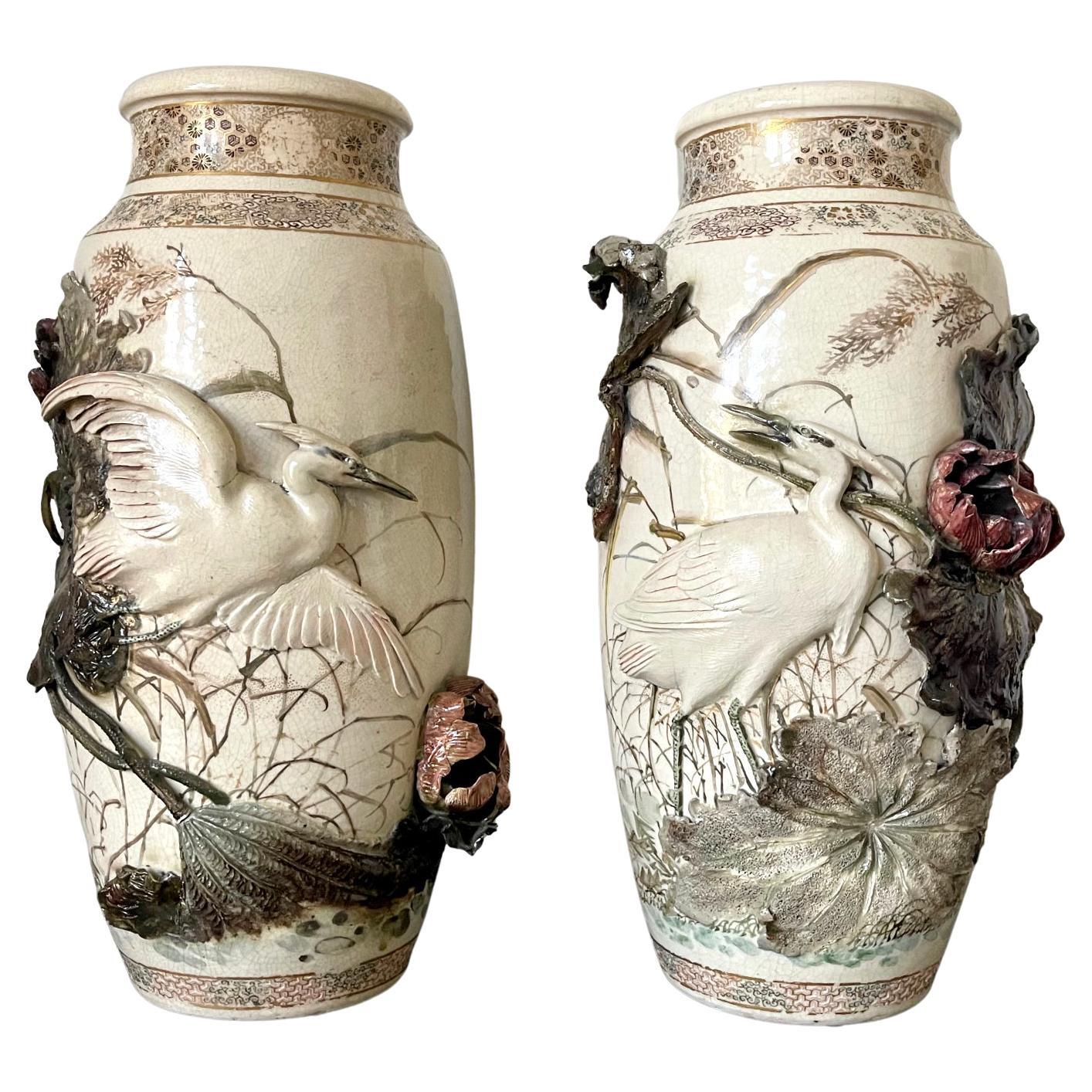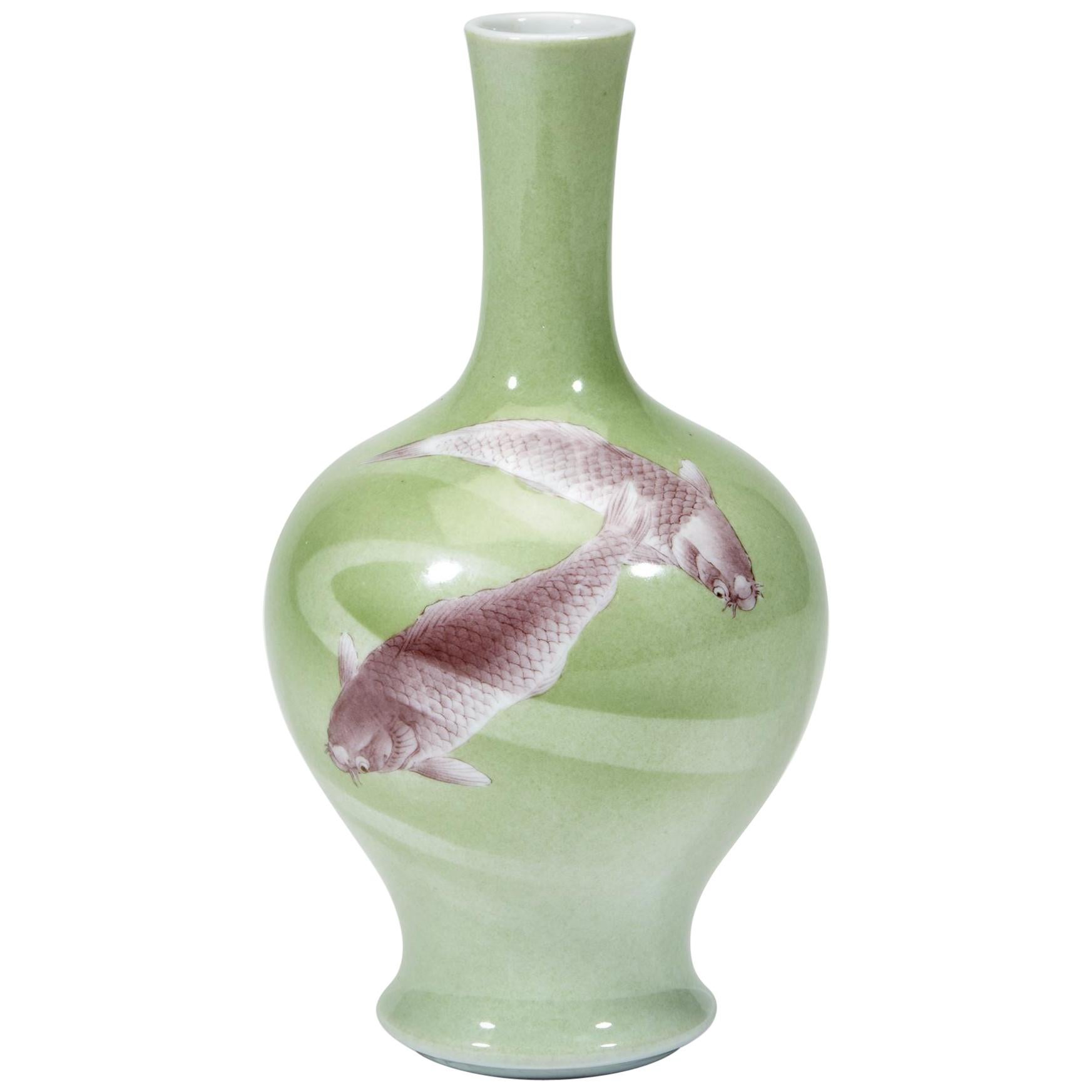Items Similar to Japanese Porcelain Vase with Relief Surface Makuzu Kozan
Want more images or videos?
Request additional images or videos from the seller
1 of 18
Japanese Porcelain Vase with Relief Surface Makuzu Kozan
About the Item
A rare porcelain vase by Makuzu Kozan (1842-1916) circa 1870-81 (late Meiji period). The vase is dated to the earlier work from Kozan's studio during his early period (Takauki-ware period, 1876-1881), when surface relief sculpturing was used as a distinguished technique. Not a large quantity of the examples remained.
The vase features a classic form of a storage jar with short neck and wide round mouth and raised shoulder. The entire surface was decorated with fine horizontal lines of ring, upon which enamel paintings of magpie birds in flight and swaying autumn grasses. The low relief sculpturing depicts a scrolling grape vines with leaves and clusters of grapes, all rendered in a highly realistic manner with colors. Together, it forms a lovely autumn scenery. The vase is marked with a branded gourd seal "Makuzu Kozan" underneath.
For a similar takauki vase with grape decoration, see Retrospective Makuzu Kozan Miyagawa Collection Book: page 131.
- Creator:Makuzu Kozan (Artist)
- Dimensions:Height: 10.5 in (26.67 cm)Diameter: 7 in (17.78 cm)
- Style:Japonisme (Of the Period)
- Materials and Techniques:
- Place of Origin:
- Period:
- Date of Manufacture:1876-81
- Condition:Wear consistent with age and use. minor surface wear such as rubbing losses of gilt on spots, a couple of fire kiln firing cracks on the vines as shown as well as rings in the interior base as shown, contact wear on the base rim.
- Seller Location:Atlanta, GA
- Reference Number:1stDibs: LU945021925612
About the Seller
5.0
Platinum Seller
These expertly vetted sellers are 1stDibs' most experienced sellers and are rated highest by our customers.
Established in 2006
1stDibs seller since 2010
477 sales on 1stDibs
Typical response time: <1 hour
- ShippingRetrieving quote...Ships From: Atlanta, GA
- Return PolicyA return for this item may be initiated within 2 days of delivery.
More From This SellerView All
- Japanese Porcelain Vase Makuzu Kozan Meiji PeriodBy Makuzu KozanLocated in Atlanta, GAA striking blue and white vase from the studio of Japanese Potter Makuzu Kozan, also known as Miyagawa Kozan (1842–1916), one of the most established and collected ceramist from Meiji Period. Born as Miyagawa Toranosuke, Kozan established his pottery studio in Yokohama circa 1870s and later became one of the appointed artists to the Japanese Imperial household. His work was exhibited in many international fairs that the Meiji government participated at the turn of the century and won many grand prizes. Of a relatively large size, this vase is decorated with underglaze cobalt blue using the novel technique developed by Kozan called Fuki-e (the blow painting). As a result, the bamboos appear took on a three-dimensional quality as if appearing in a mist. Known as one of the most creative ceramists, circa 1887, Kozan started experimenting with new chemical colors from the West in the format of his porcelain glaze. New colors allowed him to create underglaze design that appeared bright, smooth and glossy. He even invented his own receipt of cobalt blue to achieve a much brighter yet softer shade, as evident on this vase. To create landscape that is realistic and dimensional, more common in the western paintings, he was inspired by the native Japanese ink painting technique developed around 1900 by Yokoyama Taikan...Category
Antique Early 1900s Japanese Japonisme Ceramics
MaterialsCeramic
- Rare and Large Japanese Porcelain Vase Makuzu KozanBy Makuzu KozanLocated in Atlanta, GAA striking blue and white vase from the studio of Japanese Potter Makuzu Kozan, also known as Miyagawa Kozan (1842–1916), one of the most established and collected ceramist from Meiji Period. Born as Miyagawa Toranosuke, Kozan established his pottery studio in Yokohama around 1870s and later became one of the appointed artist to the Japanese Imperial household. His work was exhibited in many international fairs that the Meiji government participated at the turn of the century and won many grand prizes. With an impressively large size, this vase was likely made and reserved as a presentation piece for one of the many expositions the studio participated in the early 20th century. It was decorated with underglaze cobalt blue using the novel technique developed by Kozan called Fuki-e (the blow painting), in order to achieve the striking dimensional literary landscape known as "Mountain and Water". Being one of the most creative ceramists, Kozan started experimenting with new chemical colors from the West in the format of his porcelain glaze around 1880s. New colors allowed him to create underglaze designs that appeared bright, smooth and glossy. He even invented his own receipt of cobalt blue to achieve a much brighter yet softer shade, as evident on this vase. To create landscape that is realistic and dimensional, more common in the western paintings, he was inspired by the native Japanese ink painting technique developed around 1900 by Yokoyama Taikan...Category
Early 20th Century Japanese Japonisme Ceramics
MaterialsPorcelain
- Japanese Porcelain Vase Meiji Period Makuzu KozanBy Makuzu KozanLocated in Atlanta, GAA finely decorated and glazed Japanese porcelain vase by Makuzu Kozan (1842-1916) circa 1900s Meiji Period. The vase is of a classic bottle form with baluster body and short neck. It was decorated with underglaze white magnolia blossom on a pleasant celadon background. The stamens of the flower were artistically rendered in a low relief, giving the design a realistic appeal with the dimension. Miyagawa Kozan...Category
Early 20th Century Japanese Meiji Ceramics
MaterialsPorcelain
- Japanese Ceramic Vase with Delicate Carvings by Makuzu Kozan Meiji PeriodBy Makuzu KozanLocated in Atlanta, GAA delicate and rare Japanese ceramic vase by the important Meiji imperial potter Makuzu Kozan (1842-1916) circa 1887-1910. Dated to his underglaze phase post 1887 after he successful...Category
Antique 1890s Japanese Japonisme Ceramics
MaterialsCeramic
- Rare Pair of Early Period Makuzu Kozan Takauki High-Relief VasesBy Makuzu KozanLocated in Atlanta, GAA stunning pair of ceramic vases with gilt, paint and high-relief decoration by imperial artist Makuzu Kozan (1842-1916, also known as Miyagawa Kozan) circa 1876-81 (late Meiji period). These vases belong to early period (1876-1881) of Kozan's repertoire, during which time the high relief sculpturing (known as Takauki ware) was used as a distinguished technique on top of the traditional gilt and paint ornaments of satsuma ware. Due to the relatively limited production and the fragile nature of these wares, not a large quantity of the examples remained in the first place, not mentioning a fine matching signed pair in such impressive sizes. Not only a rarity, this pair of vases is also superb in workmanship, thus the fine example of the work from that short and unique period of the artist's career before he switched to the underglaze period. In a conceptually mirrored fashion, the surface is richly decorated with flying cranes among large lotus leaves and flower, like an idyllic aqua scenery of pure poetry on a circular scroll. The high-relief appliques were rendered and composed in realistic fashion but with a dramatic touch. They are literally about to break the surface free, alive and in motion. The dark colors of the glaze were used to set a moody tone. The approach to create this type of ornamentations is more akin to sculpturing an ink painting in three-dimension than ceramic making. It is not hard to imagine the demand of both the artistry and the technique. Both vases were signed as "Makuzu Kozan Kiln" and each further with another name and seal, which are most likely the individual artist involved in the making process. Similar signatures can be seen in the reference book below. For similarly Takauki vases, see Miyagawa Kozan Makuzu...Category
Antique 1870s Japanese Japonisme Ceramics
MaterialsCeramic
- Fine Japanese Ceramic Vase Makuzu Kozan Meiji PeriodBy Makuzu KozanLocated in Atlanta, GAA Japanese long neck porcelain vase circa 1900-1910s by the studio of Miyagawa Kozan (1842–1916), one of the most established and collected Japanese ceramist from the end of Meiji Period. Commonly known as Makuzu Kozan, which also appears as the signature on his work, his originally birth name was Miyagawa Toranosuke. He was the appointed artist to the Japanese Imperial household and his work was exhibited in many international fairs that the Meiji government participated at the turn of the century. This vase features an elegant Classic form with a slender neck and slightly flared mouth above a baluster body. It was finely painted with two swimming carps in a copper red underglaze among green ribbons like waves. The background display a brilliant verdant green overall, Around the fish a poetic hazy effect was emphasized for a visual complexity by Fuki-e (the blow painting), an invention in Kozan's studio. The new technical development of chemical colors from the west was embraced circa 1900s in Kozan studio. This empowered the more creative experiments with not only colors, but also concept of dimension, which led Makuzu Kozan's work to become a bridge between East and West aesthetics. This is particularly evident in this vase with the Masterly details of the brush strokes, the expertly employment of gradient of color, and a very realistic and detailed rendering of the fish and their vivid motions. For two similar examples of Kozan's work with similar carps decoration, see Page 148-149 of the book: Sekai ni Aisa Reta ya Kimono Miyagawa Kozan Makuzu...Category
Early 20th Century Japanese Meiji Ceramics
MaterialsCeramic
You May Also Like
- Japanese Ceramic Vase by Makuzu KozanBy Makuzu Kozan IILocated in Christchurch, GBAs part of our Japanese works of art collection we are delighted to offer this charming Meiji Period 1868-1912, ceramic baluster vase from the studios of the highly coveted Imperial ...Category
Antique 19th Century Japanese Meiji Ceramics
MaterialsCeramic
- Unusual Early 20th Century Makuzu Kozan VaseBy Makuzu KozanLocated in London, GBDecorated in iron-red and green enamels with an overall design of three shish frolicking with a brocade ball, signed on the base with an impressed seal Makuzu. The storage box ti...Category
Early 20th Century Japanese Meiji Ceramics
MaterialsPorcelain
- Large Japanese Ceramic Vase by Makuzu KozanLocated in Christchurch, GBAs part of our Japanese works of art collection we are delighted to offer this tapering square form Meiji Period 1868-1912, ceramic vase from the studios of the highly coveted Imperi...Category
Antique 19th Century Japanese Ceramics
MaterialsCeramic
- Unusual Japanese Studio Vase by Makuzu Kozan IIBy Makuzu Kozan IILocated in Christchurch, GBAs part of our Japanese works of art collection we are delighted to offer this most unusual Late Meiji (1868-1912) early Taisho period (1912-1926 ), globular vase stemming from the h...Category
Vintage 1920s Japanese Taisho Ceramics
MaterialsEarthenware
- Captivating Japanese Stoneware Jardiniere by Makuzu Kozan IIBy Makuzu Kozan IILocated in Christchurch, GBAs part of our Japanese works of art collection we are delighted to offer this most captivating Late Meiji (1868-1912) early Taisho period (1912-1926 ),globular stoneware vessel stem...Category
Vintage 1920s Japanese Taisho Ceramics
MaterialsStoneware
- Charming Japanese Okimono Mandarin Ducks - Makuzu Kozan IIBy Makuzu Kozan IILocated in Christchurch, GBAs part of our Japanese works of art collection we are delighted to offer this most charming late Meiji (1868-1912) Taisho period (1912-1926) , ceramic study of Mandarin ducks from ...Category
Vintage 1920s Japanese Taisho Ceramics
MaterialsCeramic





